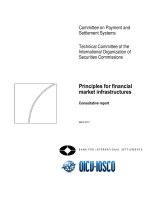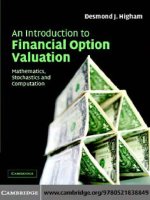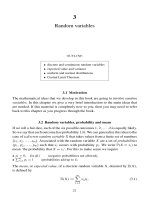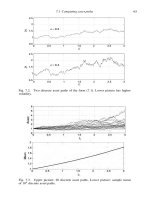Financial enginneering computation principles, mathematics algorithms
Bạn đang xem bản rút gọn của tài liệu. Xem và tải ngay bản đầy đủ của tài liệu tại đây (9.66 MB, 648 trang )
FINANCIAL ENGINEERING AND COMPUTATION
During the past decade many sophisticated mathematical and
computational techniques have been developed for analyzing
financial markets. Students and professionals intending to work in
any area of finance must not only master advanced concepts and
mathematical models but must also learn how to implement these
models computationally. This comprehensive text combines a
thorough treatment of the theory and mathematics behind
financial engineering with an emphasis on computation, in
keeping with the way financial engineering is practiced in today’s
capital markets.
Unlike most books on investments, financial engineering, or
derivative securities, the book starts from basic ideas in finance
and gradually builds up the theory. The advanced mathematical
concepts needed in modern finance are explained at accessible
levels. Thus it offers a thorough grounding in the subject for
MBAs in finance, students of engineering and sciences who are
pursuing a career in finance, researchers in computational finance,
system analysts, and financial engineers.
Building on the theory, the author presents algorithms for
computational techniques in pricing, risk management, and
portfolio management, together with analyses of their efficiency.
Pricing financial and derivative securities is a central theme of the
book. A broad range of instruments is treated: bonds, options,
futures, forwards, interest rate derivatives, mortgage-backed
securities, bonds with embedded options, and more. Each
instrument is treated in a short, self-contained chapter for ready
reference use.
Many of these algorithms are coded in Java as programs for
the Web, available from the book’s home page:
www.csie.ntu.edu.tw/∼lyuu/Capitals/capitals.htm. These
programs can be executed on Windows, MacOS, or Unix
platforms.
Yuh-Dauh Lyuu received his Ph.D. in computer science from
Harvard University. His past positions include Member of
Technical Staff at Bell Labs, Research Scientist at NEC Research
Institute (Princeton), and Assistant Vice President at Citicorp
Securities (New York). He is currently Professor of Computer
Science and Information Engineering and Professor of Finance,
National Taiwan University. His previous book is Information
Dispersal and Parallel Computation.
Professor Lyuu has published works in both computer
science and finance. He also holds a U.S. patent. Professor Lyuu
received several awards for supervising outstanding graduate
students’ theses.
i
FINANCIAL ENGINEERING
AND COMPUTATION
Principles, Mathematics, Algorithms
YUH-DAUH LYUU
National Taiwan University
iii
The Pitt Building, Trumpington Street, Cambridge, United Kingdom
The Edinburgh Building, Cambridge CB2 2RU, UK
40 West 20th Street, New York, NY 10011-4211, USA
477 Williamstown Road, Port Melbourne, VIC 3207, Australia
Ruiz de Alarcón 13, 28014 Madrid, Spain
Dock House, The Waterfront, Cape Town 8001, South Africa
© Yuh-Dauh Lyuu 2004
First published in printed format 2002
ISBN 0-511-04094-6 eBook (netLibrary)
ISBN 0-521-78171-X hardback
In Loving Memory of RACHEL and JOSHUA
v
Contents
Preface
page xiii
Useful Abbreviations
1 Introduction
1.1 Modern Finance: A Brief History
1.2 Financial Engineering and Computation
1.3 Financial Markets
1.4 Computer Technology
2 Analysis of Algorithms
2.1 Complexity
2.2 Analysis of Algorithms
2.3 Description of Algorithms
2.4 Software Implementation
3 Basic Financial Mathematics
3.1 Time Value of Money
3.2 Annuities
3.3 Amortization
3.4 Yields
3.5 Bonds
xvii
1
1
1
2
4
7
7
8
9
10
11
11
14
15
17
24
4 Bond Price Volatility
32
4.1 Price Volatility
4.2 Duration
4.3 Convexity
32
34
41
5 Term Structure of Interest Rates
5.1
5.2
5.3
5.4
5.5
5.6
5.7
5.8
Introduction
Spot Rates
Extracting Spot Rates from Yield Curves
Static Spread
Spot Rate Curve and Yield Curve
Forward Rates
Term Structure Theories
Duration and Immunization Revisited
45
45
46
47
49
50
50
56
60
vii
viii
Contents
6 Fundamental Statistical Concepts
6.1 Basics
6.2 Regression
6.3 Correlation
6.4 Parameter Estimation
7 Option Basics
7.1 Introduction
7.2 Basics
7.3 Exchange-Traded Options
7.4 Basic Option Strategies
8 Arbitrage in Option Pricing
8.1
8.2
8.3
8.4
8.5
8.6
The Arbitrage Argument
Relative Option Prices
Put–Call Parity and Its Consequences
Early Exercise of American Options
Convexity of Option Prices
The Option Portfolio Property
9 Option Pricing Models
9.1
9.2
9.3
9.4
9.5
Introduction
The Binomial Option Pricing Model
The Black–Scholes Formula
Using the Black–Scholes Formula
American Puts on a Non-Dividend-Paying
Stock
9.6 Options on a Stock that Pays Dividends
9.7 Traversing the Tree Diagonally
10 Sensitivity Analysis of Options
10.1 Sensitivity Measures (“The Greeks”)
10.2 Numerical Techniques
11 Extensions of Options Theory
11.1
11.2
11.3
11.4
11.5
11.6
11.7
Corporate Securities
Barrier Options
Interest Rate Caps and Floors
Stock Index Options
Foreign Exchange Options
Compound Options
Path-Dependent Derivatives
12 Forwards, Futures, Futures Options, Swaps
12.1
12.2
12.3
12.4
12.5
Introduction
Forward Contracts
Futures Contracts
Futures Options and Forward Options
Swaps
64
64
69
71
72
75
75
76
77
78
84
84
85
86
88
89
90
92
92
93
104
111
113
114
118
123
123
127
131
131
137
140
141
143
147
148
155
155
156
161
168
173
Contents
13 Stochastic Processes and Brownian Motion
13.1
13.2
13.3
13.4
Stochastic Processes
Martingales (“Fair Games”)
Brownian Motion
Brownian Bridge
14 Continuous-Time Financial Mathematics
14.1
14.2
14.3
14.4
177
177
179
183
188
190
Stochastic Integrals
Ito Processes
Applications
Financial Applications
190
193
197
201
15 Continuous-Time Derivatives Pricing
206
15.1
15.2
15.3
15.4
15.5
Partial Differential Equations
The Black–Scholes Differential Equation
Applications
General Derivatives Pricing
Stochastic Volatility
16 Hedging
16.1 Introduction
16.2 Hedging and Futures
16.3 Hedging and Options
17 Trees
17.1 Pricing Barrier Options with
Combinatorial Methods
17.2 Trinomial Tree Algorithms
17.3 Pricing Multivariate Contingent Claims
18 Numerical Methods
18.1 Finite-Difference Methods
18.2 Monte Carlo Simulation
18.3 Quasi–Monte Carlo Methods
19 Matrix Computation
19.1 Fundamental Definitions and Results
19.2 Least-Squares Problems
19.3 Curve Fitting with Splines
20 Time Series Analysis
20.1 Introduction
20.2 Conditional Variance Models for Price Volatility
21 Interest Rate Derivative Securities
21.1
21.2
21.3
21.4
Interest Rate Futures and Forwards
Fixed-Income Options and Interest Rate Options
Options on Interest Rate Futures
Interest Rate Swaps
206
207
211
220
221
224
224
224
228
234
234
242
245
249
249
255
262
268
268
273
278
284
284
291
295
295
306
310
312
ix
x
Contents
22 Term Structure Fitting
22.1
22.2
22.3
22.4
22.5
Introduction
Linear Interpolation
Ordinary Least Squares
Splines
The Nelson–Siegel Scheme
23 Introduction to Term Structure Modeling
23.1
23.2
23.3
23.4
Introduction
The Binomial Interest Rate Tree
Applications in Pricing and Hedging
Volatility Term Structures
24 Foundations of Term Structure Modeling
24.1
24.2
24.3
24.4
24.5
24.6
24.7
Terminology
Basic Relations
Risk-Neutral Pricing
The Term Structure Equation
Forward-Rate Process
The Binomial Model with Applications
Black–Scholes Models
25 Equilibrium Term Structure Models
25.1
25.2
25.3
25.4
25.5
The Vasicek Model
The Cox-Ingersoll-Ross Model
Miscellaneous Models
Model Calibration
One-Factor Short Rate Models
26 No-Arbitrage Term Structure Models
26.1
26.2
26.3
26.4
26.5
26.6
Introduction
The Ho–Lee Model
The Black–Derman–Toy Model
The Models According to Hull and White
The Heath–Jarrow–Morton Model
The Ritchken–Sankarasubramanian Model
27 Fixed-Income Securities
27.1
27.2
27.3
27.4
27.5
Introduction
Treasury, Agency, and Municipal Bonds
Corporate Bonds
Valuation Methodologies
Key Rate Durations
28 Introduction to Mortgage-Backed Securities
28.1
28.2
28.3
28.4
Introduction
Mortgage Banking
Agencies and Securitization
Mortgage-Backed Securities
321
321
322
323
325
326
328
328
329
337
343
345
345
346
348
350
353
353
359
361
361
364
370
371
372
375
375
375
380
384
388
395
399
399
399
401
406
412
415
415
416
417
419
Contents
28.5 Federal Agency Mortgage-Backed
Securities Programs
28.6 Prepayments
422
423
29 Analysis of Mortgage-Backed Securities
427
29.1
29.2
29.3
29.4
Cash Flow Analysis
Collateral Prepayment Modeling
Duration and Convexity
Valuation Methodologies
30 Collateralized Mortgage Obligations
30.1
30.2
30.3
30.4
30.5
30.6
Introduction
Floating-Rate Tranches
PAC Bonds
TAC Bonds
CMO Strips
Residuals
31 Modern Portfolio Theory
31.1
31.2
31.3
31.4
Mean–Variance Analysis of Risk and Return
The Capital Asset Pricing Model
Factor Models
Value at Risk
32 Software
32.1 Web Programming
32.2 Use of The Capitals Software
32.3 Further Topics
427
440
444
446
451
451
452
453
457
457
457
458
458
464
470
474
480
480
480
482
33 Answers to Selected Exercises
484
Bibliography
553
Glossary of Useful Notations
585
Index
587
xi
Preface
[A book] is a node within a network.
Michel Foucault (1926–1984), The Archaeology of Knowledge
Intended Audience
As the title of this book suggests, a modern book on financial engineering has to
cover investment theory, financial mathematics, and computer science evenly. This
interdisciplinary emphasis is tuned more to the capital markets wherever quantitative analysis is being practiced. After all, even economics has moved away from a
time when “the bulk of [Alfred Marshall’s] potential readers were both unable and
unwilling to read economics in mathematical form” according to Viner (1892–1970)
[860] toward the new standard of which Markowitz wrote in 1987, “more than half
my students cannot write down the formal definition of [the limit of a sequence]”
[642].
This text is written mainly for students of engineering and the natural sciences
who want to study quantitative finance for academic or professional reasons. No
background in finance is assumed. Years of teaching students of business administration convince me that technically oriented MBA students will benefit from the
book’s emphasis on computation. With a sizable bibliography, the book can serve as
a reference for researchers.
This text is also written for practitioners. System analysts will find many compact
and useful algorithms. Portfolio managers and traders can obtain the quantitative
underpinnings for their daily activities. This work also serves financial engineers in
their design of financial instruments by expounding the underlying principles and
the computational means to pricing them.
The marketplace has already offered several excellent books on derivatives (e.g.,
[236, 470, 514, 746, 878]), financial engineering (e.g., [369, 646, 647]), financial theory
(e.g., [290, 492]), econometrics (e.g., [147]), numerical techniques (e.g., [62, 215]),
and financial mathematics (e.g., [59, 575, 692, 725]). There are, however, few books
that come near to integrating the wide-ranging disciplines. I hope this text succeeds
at least partially in that direction and, as a result, one no longer has to buy four or
five books to get good coverage of the topics.
xiii
xiv
Preface
Presentation
This book is self-contained. Technically sophisticated undergraduates and graduates
should be able to read it on their own. Mathematical materials are added where they
are needed. In many instances, they provide the coupling between earlier chapters
and upcoming themes. Applications to finance are generally added to set the stage.
Numerical techniques are presented algorithmically and clearly; programming them
should therefore be straightforward. The underlying financial theory is adequately
covered, as understanding the theory underlying the calculations is critical to financial
innovations.
The large number of exercises is an integral part of the text. Exercises are placed
right after the relevant materials. Hints are provided for the more challenging ones.
There are also numerous programming assignments. Those readers who aspire to become software developers can learn a lot by implementing the programming assignments. Thoroughly test your programs. The famous adage of Hamming (1916–1998),
“The purpose of computing is insight, not numbers,” does not apply to erroneous
codes. Answers to all nontrivial exercises and some programming assignments can
be found near the end of the book.
Most of the graphics were produced with Mathematica [882]. The programs that
generate the data for the plots have been written in various languages, including C,
C++, Java, JavaScript, Basic, and Visual Basic. It is a remarkable fact that most – if
not all – of the programming works could have been done with spreadsheet software
[221, 708]. Some computing platforms admit the integration of the spreadsheet’s
familiar graphical user interface and programs written in more efficient high-level
programming languages [265]. Although such a level of integration requires certain
sophistication, it is a common industry practice. Freehand graphics were created with
Canvas and Visio.
The manuscript was typeset in LATEX [580], which is ideal for a work of this size
and complexity. I thank Knuth and Lamport for their gifts to technical writers.
Software
Many algorithms in the book have been programmed. However, instead of being
bundled with the book in disk, my software is Web-centric and platform-independent
[412]. Any machine running a World Wide Web browser can serve as a host for those
programs on The Capitals page at
www.csie.ntu.edu.tw/∼lyuu/capitals.html
There is no more need for the (rare) author to mail the upgraded software to the
reader because the one on the Web page is always up to date. This new way of software
development and distribution, made possible by the Web, has turned software into
an Internet service.
Organization
Here is a grand tour of the book:
Chapter 1 sets the stage and surveys the evolution of computer technology.
Preface
Chapter 2 introduces algorithm analysis and measures of complexity. My convention for expressing algorithms is outlined here.
Chapter 3 contains a relatively complete treatment of standard financial mathematics, starting from the time value of money.
Chapter 4 covers the important concepts of duration and convexity.
Chapter 5 goes over the static term structure of interest rates. The coverage of
classic, static finance theory ends here.
Chapter 6 marks the transition to stochastic models with coverage of statistical
inference.
Chapters 7--12 are about options and derivatives. Chapter 7 presents options and
basic strategies with options. Chapter 8 introduces the arbitrage argument and derives
general pricing relations. Chapter 9 is a key chapter. It covers option pricing under the
discrete-time binomial option pricing model. The celebrated Black–Scholes formulas
are derived here, and algorithms for pricing basic options are presented. Chapter 10
presents sensitivity measures for options. Chapter 11 covers the diverse applications
and kinds of options. Additional derivative securities such as forwards and futures
are treated in Chap. 12.
Chapters 13--15 introduce the essential ideas in continuous-time financial mathematics. Chapter 13 covers martingale pricing and Brownian motion, and Chap. 14
moves on to stochastic integration and the Ito process. Together they give a fairly
complete treatment of the subjects at an accessible level. From time to time, we go
back to discrete-time models and establish the linkage. Chapter 15 focuses on the
partial differential equations that derivative securities obey.
Chapter 16 covers hedging by use of derivatives.
Chapters 17--20 probe deeper into various technical issues. Chapter 17 investigates binomial and trinomial trees. One of the motives here is to demonstrate the use
of combinatorics in designing highly efficient algorithms. Chapter 18 covers numerical methods for partial differential equations, Monte Carlo simulation, and quasi–
Monte Carlo methods. Chapter 19 treats computational linear algebra, least-squares
problems, and splines. Factor models are presented as an application. Chapter 20
introduces financial time series analysis as well as popular time-series models.
Chapters 21--27 are related to interest-rate-sensitive securities. Chapter 21 surveys the wide varieties of interest rate derivatives. Chapter 22 discusses yield curve
fitting. Chapter 23 introduces interest rate modeling and derivative pricing with the
elementary, yet important, binomial interest rate tree. Chapter 24 lays the mathematical foundations for interest rate models, and Chaps. 25 and 26 sample models from
the literature. Finally, Chap. 27 covers fixed-income securities, particularly those with
embedded options.
Chapters 28--30 are concerned with mortgage-backed securities. Chapter 28 introduces the basic ideas, institutions, and challenging issues. Chapter 29 investigates
the difficult problem of prepayment and pricing. Chapter 30 surveys collateralized
mortgage obligations.
xv
xvi
Preface
Chapter 31 discusses the theory and practice of portfolio management. In particular, it presents modern portfolio theory, the Capital Asset Pricing Model, the Arbitrage Pricing Theory, and value at risk.
Chapter 32 documents the Web software developed for this book.
Chapter 33 contains answers or pointers to all nontrivial exercises.
This book ends with an extensive index. There are two guiding principles behind
its structure. First, related concepts should be grouped together. Second, the index
should facilitate search. An entry containing parentheses indicates that the term
within should be consulted instead, first at the current level and, if not found, at the
outermost level.
Acknowledgments
Many people contributed to the writing of the book: George Andrews, Nelson
Beebe, Edward Bender, Alesandro Bianchi, Tomas Bjork,
¨
Peter Carr, Ren-Raw
Chen, Shu-Heng Chen, Oren Cheyette, Jen-Diann Chiou, Mark Fisher, Ira Gessel,
Mau-Wei Hung, Somesh Jha, Ming-Yang Kao, Gow-Hsing King, Timothy Klassen,
Philip Liang, Steven Lin, Mu-Shieung Liu, Andrew Lo, Robert Lum, Chris McLean,
Michael Rabin, Douglas Rogers, Masako Sato, Erik Schlogl,
¨ James Tilley, and Keith
Weintraub.
Ex-colleagues at Citicorp Securities, New York, deserve my deep thanks for the
intellectual stimuli: Mark Bourzutschky, Michael Chu, Burlie Jeng, Ben Lis, James
Liu, and Frank Feikeh Sung. In particular, Andy Liao and Andy Sparks taught me a
lot about the markets and quantitative skills.
Students at National Taiwan University, through research or course work, helped
improve the quality of the book: Chih-Chung Chang, Ronald Yan-Cheng Chang,
Kun-Yuan Chao [179], Wei-Jui Chen [189], Yuan-Wang Chen [191], Jing-Hong Chou,
Tian-Shyr Dai, [257, 258, 259] Chi-Shang Draw, Hau-Ren Fang, Yuh-Yuan Fang,
Jia-Hau Guo [405], Yon-Yi Hsiao, Guan-Shieng Huang [250], How-Ming Hwang,
Heng-Yi Liu, Yu-Hong Liu [610], Min-Cheng Sun, Ruo-Ming Sung, Chen-Leh Wang
[867], Huang-Wen Wang [868], Hsing-Kuo Wong [181], and Chao-Sheng Wu [885].
This book benefited greatly from the comments of several anonymous reviewers.
As the first readers of the book, their critical eyes made a lasting impact on its
evolution. As with my first book with Cambridge University Press, the editors at the
Press were invaluable. In particular, I would like to thank Lauren Cowles, Joao
¨ da
Costa, Caitlin Doggart, Scott Parris, Eleanor Umali, and the anonymous copy editor.
I want to thank my wife Chih-Lan and my son Raymond for their support during
the project, which started in January 1995. This book, I hope, finally puts to rest their
dreadful question, “When are you going to finish it?”
Useful Abbreviations
Acronyms
APT
AR
ARCH
ARM
ARMA
Arbitrage Pricing Theory
autoregressive (process)
autoregressive conditional heteroskedastic
(process)
adjustable-rate mortgage
autoregressive moving average (process)
BDT
BEY
BOPM
BPV
Black–Derman–Toy (model)
bond-equivalent yield
binomial option pricing model
basis-point value
CAPM
CB
CBOE
CBT
CD
CIR
CME
CMO
CMT
COFI
CPR
Capital Asset Pricing Model
convertible bond
Chicago Board of Exchange
Chicago Board of Trade
certificate of deposit
Cox–Ingersoll–Ross
Chicago Mercantile Exchange
collateralized mortgage obligation
constant-maturity Treasury (rate)
Cost of Funds Index
conditional prepayment rate
DEM
DJIA
German mark
Dow Jones Industrial Average
FHA
FHLMC
Federal Housing Administration
Federal Home Loan Mortgage Corporation
(“Freddie Mac”)
Federal National Mortgage Association
(“Fannie Mae”)
foreign exchange
forward rate agreement
future value
FNMA
forex
FRA
FV
xvii
xviii
Useful Abbreviations
GARCH generalized autoregressive conditional
heteroskedastic
GLS
generalized least-squares
GMM
generalized method of moments
GNMA Government National Mortgage Association
(“Ginnie Mae”)
HJM
HPR
Heath–Jarrow–Morton
holding period return
IAS
IMM
IO
IRR
index-amortizing swap
International Monetary Market
interest-only
internal rate of return
JPY
Japanese yen
LIBOR
LTCM
London Interbank Offered Rate
Long-Term Capital Management
MA
MBS
MD
ML
MPTS
MVP
moving average
mortgage-backed security
Macauley duration
maximum likelihood
mortgage pass-through security
minimum-variance point
NPV
NYSE
net present value
New York Stock Exchange
OAC
OAD
OAS
OLS
option-adjusted convexity
option-adjusted duration
option-adjusted spread
ordinary least-squares
PAC
P&I
PC
PO
PSA
PV
Planned Amortization Class (bond)
principal and interest
participation certificate
principal-only
Public Securities Association
present value
REMIC
RHS
RS
Real Estate Mortgage Investment Conduit
Rural Housing Service
Ritchken–Sankarasubramanian
S&P 500
SMBS
SMM
SSE
Standard and Poor’s 500 Index
stripped mortgage-backed security
single monthly mortality
error sum of squares
Useful Abbreviations
SSR
SST
SVD
regression sum of squares
total sum of squares
singular value decomposition
TAC
Target Amortization Class (bond)
VA
VaR
Department of Veterans Affairs
value at risk
WAC
WAL
WAM
WWW
weighted average coupon
weighted average life
weighted average maturity
World Wide Web
Ticker Symbols
DJ
IRX
NDX
NYA
OEX
RUT
SPX
TYX
VLE
WSX
XMI
Dow Jones Industrial Average
thirteen-week T-bill
Nasdaq 100
New York Stock Exchange Composite Index
S&P 100
Russell 200
S&P 500
thirty-year T-bond
Value Line Index
Wilshire S-C
Major Market Index
xix
CHAPTER
ONE
Introduction
But the age of chivalry is gone. That of sophisters, oeconomists, and
calculators, has succeeded; and the glory of Europe is extinguished
for ever.
Edmund Burke (1729–1797), Reflections on the Revolution
in France
1.1 Modern Finance: A Brief History
Modern finance began in the 1950s [659, 666]. The breakthroughs of Markowitz,
Treynor, Sharpe, Lintner (1916–1984), and Mossin led to the Capital Asset Pricing Model in the 1960s, which became the quantitative model for measuring risk.
Another important influence of research on investment practice in the 1960s was
the Samuelson–Fama efficient markets hypothesis, which roughly says that security
prices reflect information fully and immediately. The most important development in
terms of practical impact, however, was the Black–Scholes model for option pricing
in the 1970s. This theoretical framework was instantly adopted by practitioners. Option pricing theory is one of the pillars of finance and has wide-ranging applications
[622, 658]. The theory of option pricing can be traced to Louis Bachelier’s Ph.D. thesis
in 1900, “Mathematical Theory of Speculation.” Bachelier (1870–1946) developed
much of the mathematics underlying modern economic theories on efficient markets,
random-walk models, Brownian motion [ahead of Einstein (1879–1955) by 5 years],
and martingales [277, 342, 658, 776].1
1.2 Financial Engineering and Computation
Today, the wide varieties of financial instruments dazzle even the knowledgeable.
Individuals and corporations can trade, in addition to stocks and bonds, options,
futures, stock index options, and countless others. When it comes to diversification, one has thousands of mutual funds and exchange-traded funds to choose from.
Corporations and local governments increasingly use complex derivative securities
to manage their financial risks or even to speculate. Derivative securities are financial instruments whose values depend on those of other assets. All are the fruits of
financial engineering, which means structuring financial instruments to target investor preferences or to take advantage of arbitrage opportunities [646].
1
2
Introduction
The innovations in the financial markets are paralleled by equally explosive
progress in computer technology. In fact, one cannot think of modern financial
systems without computers: automated trading, efficient bookkeeping, timely clearing and settlements, real-time data feed, online trading, day trading, large-scale
databases, and tracking and monitoring of market conditions [647, 866]. These
applications deal with information. Structural changes and increasing volatility in
financial markets since the 1970s as well as the trend toward greater complexity
in financial product design call for quantitative techniques. Today, most investment
houses use sophisticated models and software on which their traders depend. Here,
computers are used to model the behavior of financial securities and key indicators,
price financial instruments, and find combinations of financial assets to achieve
results consistent with risk exposures. The confidence in such models in turn leads
to more financial innovations and deeper markets [659, 661]. These topics are the
focus of financial computation.
One must keep in mind that every computation is based on input and assumptions
made by the model. However, input might not be accurate enough or complete,
and the assumptions are, at best, approximations.2 Computer programs are also
subject to errors (“bugs”). These factors easily defeat any computation. Despite
these difficulties, the computer’s capability of calculating with fine details and trying
out vast numbers of scenarios is a tremendous advantage. Harnessing this power and
a good understanding of the model’s limitations should steer us clear of blind trust
in numbers.
1.3 Financial Markets
A society improves its welfare through investments. Business owners need outside capital for investments because even projects of moderate sizes are beyond
the reach of most wealthy individuals. Governments also need funds for public investments. Much of that money is channeled through the financial markets from
savers to borrowers. In so doing, the financial markets provide a link between saving and investment,3 and between the present and the future. As a consequence,
savers can earn higher returns from their savings instead of hoarding them, borrowers can execute their investment plans to earn future profits, and both are better off.
The economy also benefits by acquiring better productive capabilities as a result.
Financial markets therefore facilitate real investments by acting as the sources of
information.
A financial market typically takes its name from the borrower’s side of the market:
the government bond market, the municipal bond market, the mortgage market,
the corporate bond market, the stock market, the commodity market, the foreign
exchange (forex) market,4 the futures market, and so on [95, 750]. Within financial
markets, there are two basic types of financial instruments: debt and equity. Debt
instruments are loans with a promise to repay the funds with interest, whereas equity
securities are shares of stock in a company. As an example, Fig. 1.1 traces the U.S.
markets of debt securities between 1985 and 1999. Financial markets are often divided
into money markets, which concentrate on short-term debt instruments, and capital
markets, which trade in long-term debt (bonds) and equity instruments (stocks)
[767, 799, 828].
1.3 Financial Markets
Outstanding U.S. Debt Market Securities (U.S. $ billions)
Year
Municipal
Treasury
Agency
MBSs
U.S.
corporate
Fed
agencies
Money
market
Assetbacked
Total
1985
1986
1987
1988
1989
1990
1991
1992
1993
1994
1995
1996
1997
1998
1999
859.5
920.4
1,010.4
1,082.3
1,135.2
1,184.4
1,272.2
1,302.8
1,377.5
1,341.7
1,293.5
1,296.0
1,367.5
1,464.3
1,532.5
1,360.2
1,564.3
1,724.7
1,821.3
1,945.4
2,195.8
2,471.6
2,754.1
2,989.5
3,126.0
3,307.2
3,459.0
3,456.8
3,355.5
3,281.0
372.1
534.4
672.1
749.9
876.3
1,024.4
1,160.5
1,273.5
1,349.6
1,441.9
1,570.4
1,715.0
1,825.8
2,018.4
2,292.0
719.8
952.6
1,061.9
1,181.2
1,277.1
1,333.7
1,440.0
1,542.7
1,662.1
1,746.6
1,912.6
2,055.9
2,213.6
2,462.0
3,022.9
293.9
307.4
341.4
381.5
411.8
434.7
442.8
484.0
570.7
738.9
844.6
925.8
1,022.6
1,296.5
1,616.5
847.0
877.0
979.8
1,108.5
1,192.3
1,156.8
1,054.3
994.2
971.8
1,034.7
1,177.2
1,393.8
1,692.8
1,978.0
2,338.2
2.4
3.3
5.1
6.8
59.5
102.2
133.6
156.9
179.0
205.0
297.9
390.5
518.1
632.7
746.3
4,454.9
5,159.4
5,795.4
6,331.5
6,897.6
7,432.0
7,975.0
8,508.2
9,100.2
9,634.8
10,403.5
11,235.0
12,097.2
13,207.4
14,829.4
Figure 1.1: U.S. debt markets 1985–1999. The Bond Market Association estimates. Sources: Federal Home Loan
Mortgage Corporation, Federal National Mortgage Association, Federal Reserve System, Government National
Mortgage Association, Securities Data Company, and U.S. Treasury. MBS, mortgage-backed security.
Borrowers and savers can trade directly with each other through the financial
markets or direct loans. However, minimum-size requirements, transactions costs,
and costly evaluation of the assets in question often prohibit direct trades. Such
impediments are remedied by financial intermediaries. These are financial institutions that act as middlemen to transfer funds from lenders to borrowers; unlike most
firms, they hold only financial assets [660]. Banks, savings banks, savings and loan
associations, credit unions, pension funds, insurance companies, mutual funds, and
money market funds are prominent examples. Financial intermediaries can lower
the minimum investment as well as other costs for savers.
Financial markets can be divided further into primary markets and secondary
markets. The primary market is often merely a fictional, not a physical, location.
Governments and corporations initially sell securities – debt or equity – in the primary
market. Such sales can be done by means of public offerings or private placements.
A syndicate of investment banks underwrites the debt and the equity by buying
them from the issuing entities and then reselling them to the public. Sometimes the
investment bankers work on a best-effort basis to avoid the risk of not being able to
sell all the securities. Subsequently people trade those instruments in the secondary
markets, such as the New York Stock Exchange. Existing securities are exchanged
in the secondary market.
The existence of the secondary market makes securities more attractive to investors by making them tradable after their purchases. It is the very idea that created
the secondary market in mortgages in 1970 by asset securitization [54]. Securitization converts assets into traded securities with the assets pledged as collaterals, and
these assets can often be removed from the balance sheet of the bank. In so doing,
3
4
Introduction
financial intermediaries transform illiquid assets into liquid liabilities [843]. By making mortgages more attractive to investors, the secondary market also makes them
more affordable to home buyers. In addition to mortgages, auto loans, credit card
receivables, senior bank loans, and leases have all been securitized [330]. Securitization has fundamentally changed the credit market by making the capital market a
major supplier of credit, a role traditionally held exclusively by the banking system.
1.4 Computer Technology
Computer hardware has been progressing at an exponential rate. Measured by the
widely accepted integer Standard Performance Evaluation Corporation (SPEC)
benchmarks, the workstations improved their performance by 49% per year between 1987 and 1997. The memory technology is equally impressive. The dynamic
random-access memory (DRAM) has quadrupled its capacity every 3 years since
1977. Relative performance per unit cost of technologies from vacuum tube to transistor to integrated circuit to very-large-scale-integrated (VLSI) circuit is a factor of
2,400,000 between 1951 and 1995 [717].
Some milestones in the industry include the IBM/360 mainframe, followed by
Digital’s minicomputers. (Digital was acquired by Compaq in 1998.) The year 1963
saw the first supercomputer, built by Cray (1926–1996) at the Control Data Corporation. Apple II of 1977 is generally considered to be the first personal computer.
It was overtaken by the IBM Personal Computer in 1981, powered by Intel microprocessors and Microsoft’s disk operating system (DOS) [638, 717]. The 1980s
also witnessed the emergence of the so-called massively parallel computers, some of
which had more than 65,000 processors [487]. Parallel computers have also been applied to database applications [247, 263] and pricing complex financial instruments
[528, 794, 891]. Because commodity components offer the best performance/cost
ratio, personal computers connected by fast networks have been uprooting niche
parallel machines from most of their traditional markets [24, 200].
On the software side, high-level programming languages dominate [726]. Although they are easier to program with than low-level languages, it remains difficult
to design and maintain complex software systems. In fact, in the 1960s, the software
cost of the IBM/360 system already dominated its hardware cost [872]. The current
trend has been to use the object-oriented principles to encapsulate as much information as possible into the so-called objects [101, 466]. This makes software easier
to maintain and develop. Object-oriented software development systems are widely
available [178].
The revolution fostered by the graphical user interface (GUI) brought computers to the masses. The omnipotence of personal computers armed with easy-to-use
interfaces enabled employees to have access to information and to bypass several
layers of management [140]. It also paved the way for the client/server concept [736].
Client/server systems consist of components that are logically distributed rather
than centralized (see Fig. 1.2). Separate components therefore can be optimized
based on their functions, boosting the overall performance/cost ratio. For instance,
the three-tier client/server architecture contains three parts: user interface, computing (application) server, and data server [310]. Because the user interface demands fewer resources, it can run on lightly configured computers. Best of all, it can
potentially be made platform independent, thus offering maximum availability of the









